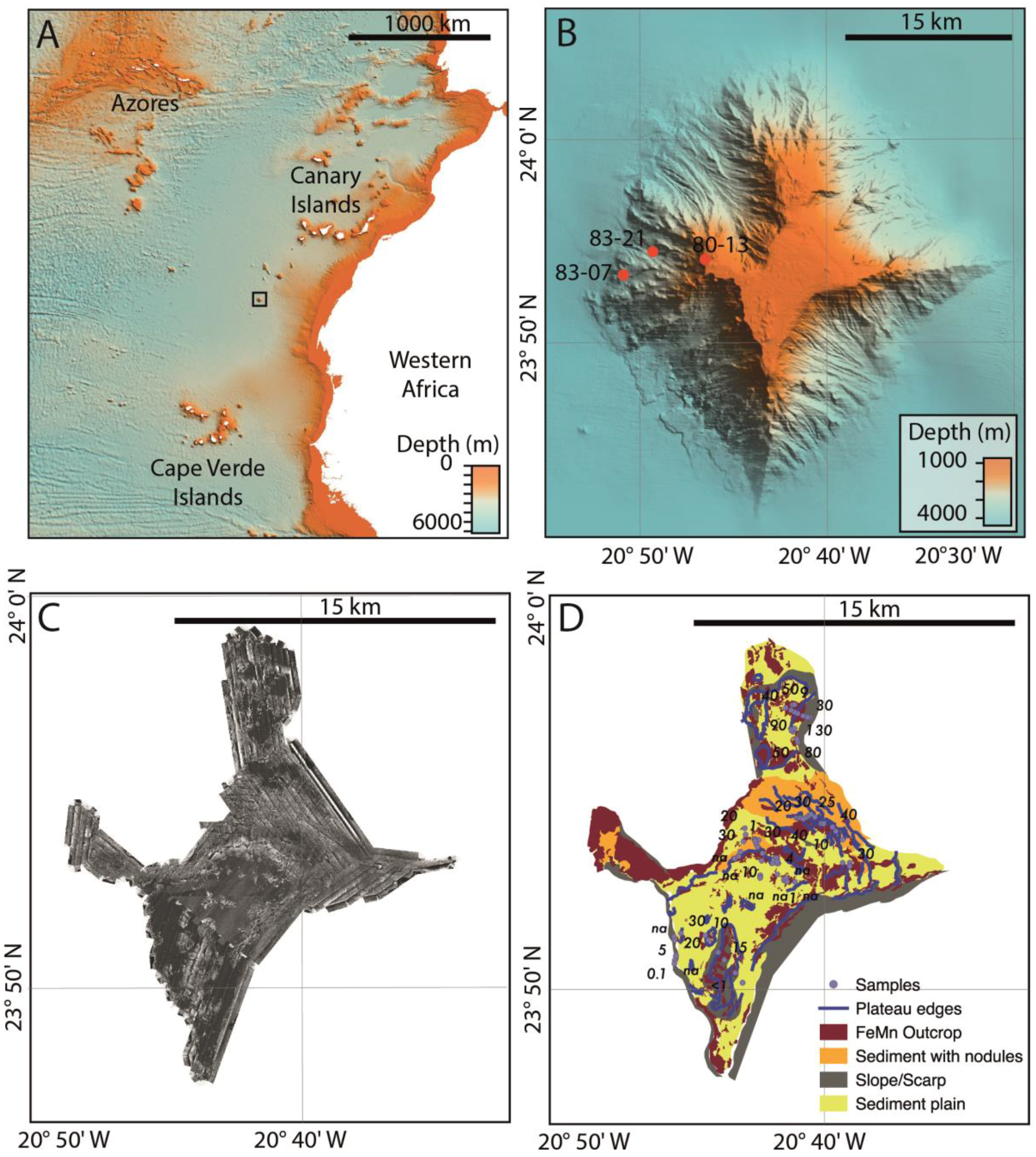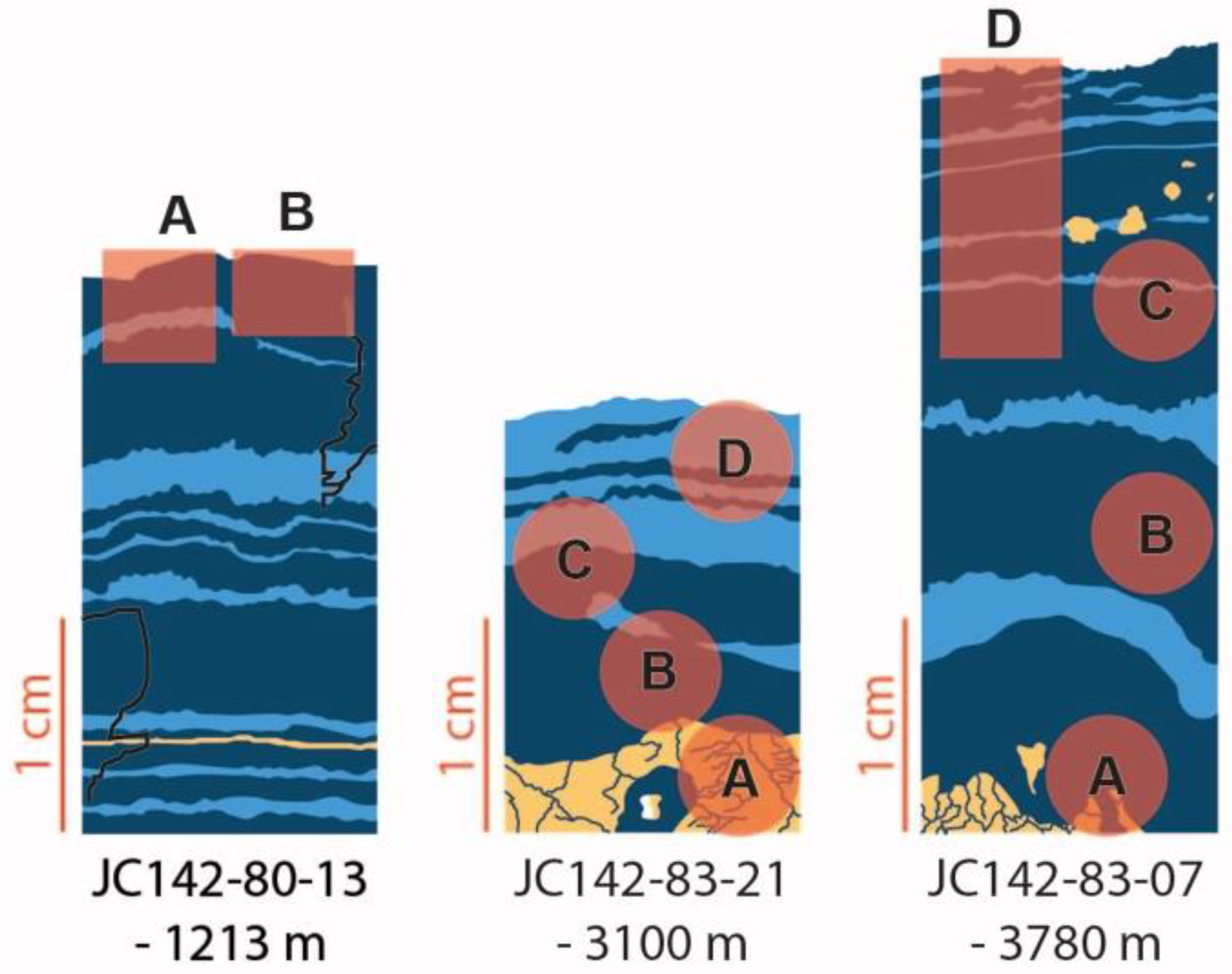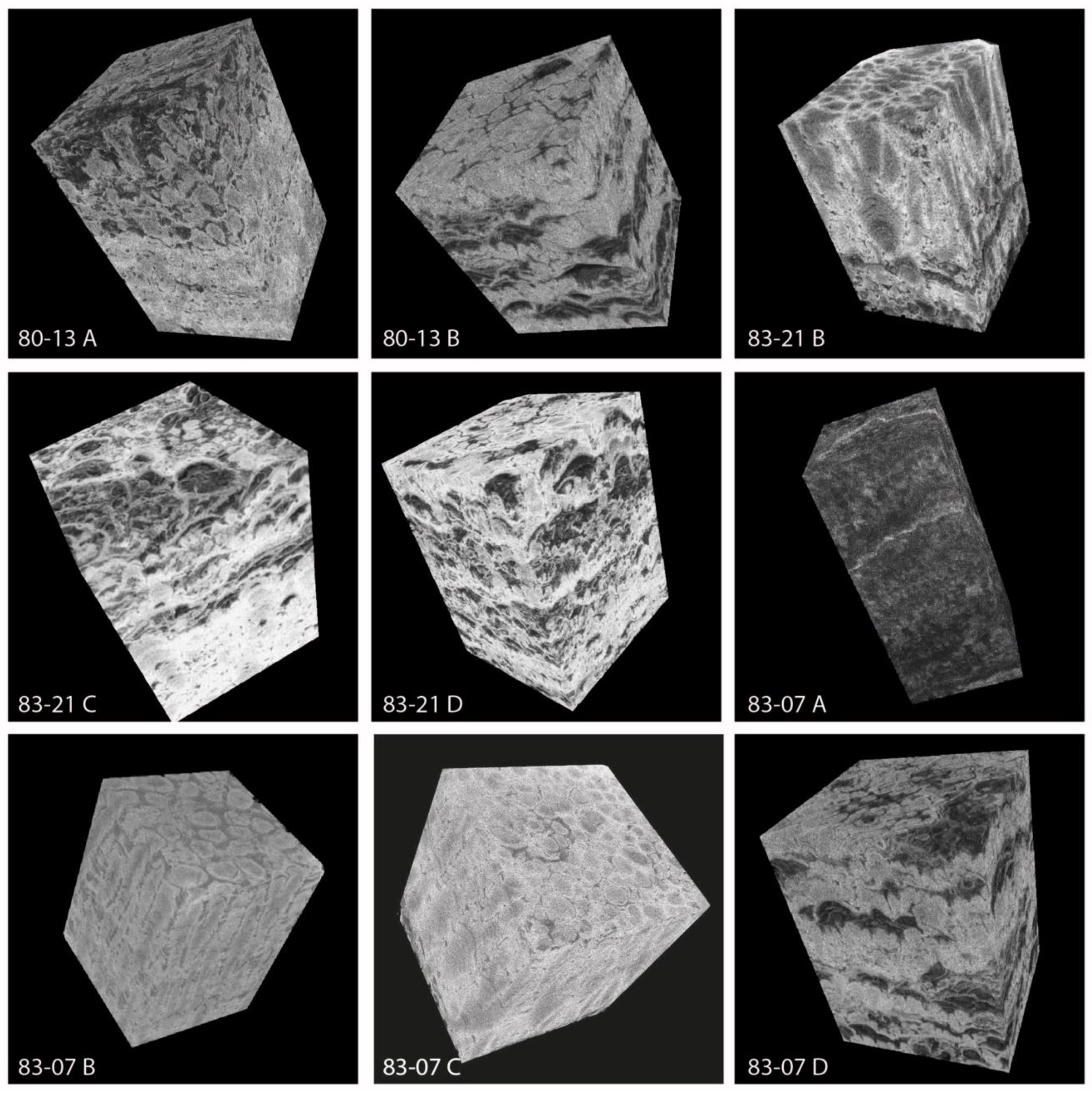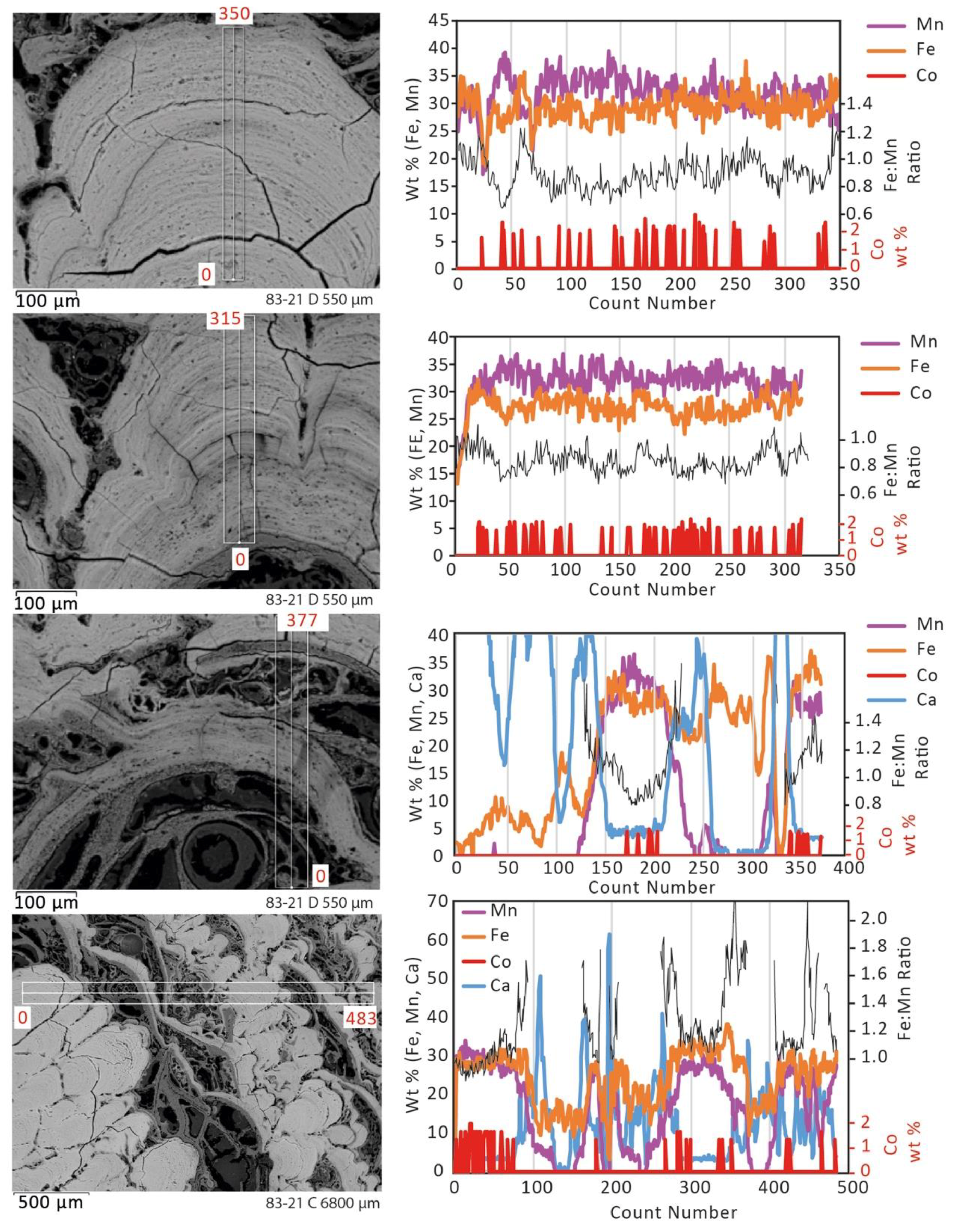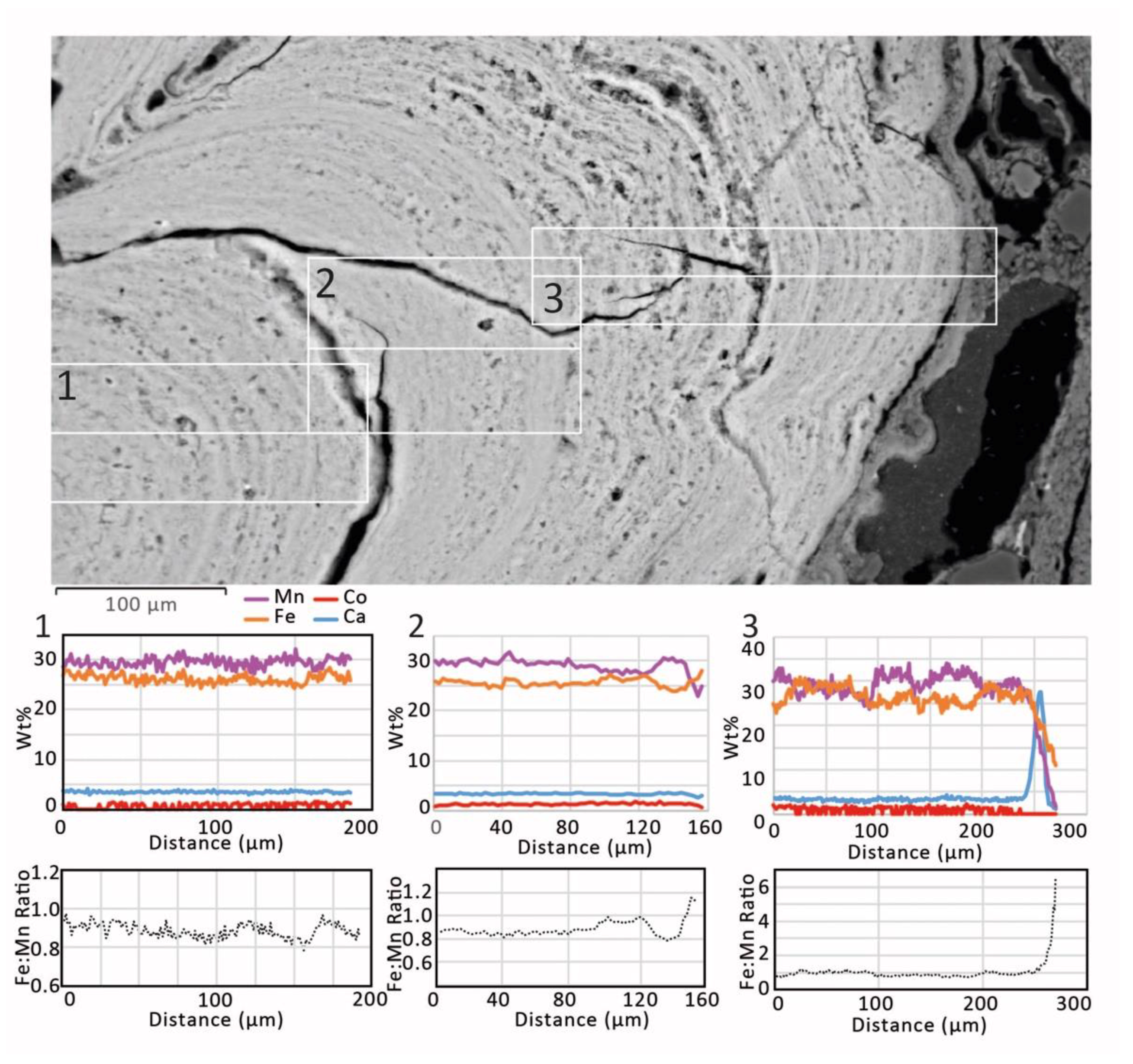1. Introduction
In response to anthropogenically induced climate change, it is essential to decarbonise power generation, transportation, and industrial processes. This can be achieved by switching from high- to low-carbon energy sources, such as renewables and electric vehicles. However, these technologies and associated infrastructure require large amounts of raw materials, including some metals that have experienced rapid demand growth in recent years (e.g., cobalt, lithium, rare earth elements (REE), and tellurium). To meet this demand and ensure the security of the supply in the future, it is necessary to consider new sources for such key metals. Seafloor ferromanganese oxides, comprising both crusts and nodules, are rich in tellurium (Te) and cobalt (Co) [
1,
2,
3,
4], both of which are in high demand. Te is primarily used in photovoltaic solar cells (40%), thermoelectric production (26%), and high-strength alloys of copper, steel, and lead (34%), whilst Co is used to produce alloys for use in high-temperature environments and in the cathodes of lithium-ion batteries used in electronic devices and vehicles. Both Te and Co have been identified as economically important or critical raw minerals, predominantly because of their use in emerging technologies (American Physical Society [
5], European Union [
6]). Yet, even if our current production rates were doubled, we are unlikely to be able to meet the predicted demands of these industries in the near future [
3,
7]. Currently more than 60% of known Co resources are found in the Democratic Republic of the Congo, where guaranteed future supply depends on maintained political stability [
8], while Te is mainly produced as a byproduct of Copper processing. As such, it is important that new, viable resources for these elements are found to meet global demand. Ferromanganese nodules (FeMn nodules) and crusts (FeMn crusts), rich in both Co and, in the case of crusts, Te, have been proposed by several authors (e.g., [
4,
9,
10,
11]) as a resource, as they are enriched in both Te and Co when compared with land-based deposits. FeMn crusts are also higher in REEs than many land deposits and FeMn nodules [
12]. In this paper, we focus on the importance of FeMn crustal structure on their value as a resource.
Most FeMn crusts are of hydrogenetic origin and composed of Fe oxyhydroxides and Mn oxides precipitated directly from cold seawater onto exposed, sediment-free rocky substrates. The availability of Fe and Mn as dissolved cations in the water column is intimately linked to the biological activity and its impact on the surrounding dissolved oxygen levels. The low levels of oxygen saturation define the so-called oxygen minimum zone (OMZ). The low oxidizing potential allows many metals to be proportionally enriched in this layer that typically extends between 200 and 700 m beneath sea-level in the North Atlantic [
13]. Seamounts, ridges, and continental platforms form topographic anomalies on the seabed, and provoke the upwelling of deep oxygenated water. Turbulent mixing between upwelling O
2-rich and metal-laden waters of the OMZ forms the basic mechanism for the precipitation of Fe and Mn oxyhydroxides. Mn
2+ rich waters from the OMZ mix with deeper oxygen-rich waters and oxidize Mn and other metals to form colloids that then scavenge trace metals and precipitate on hard, rocky surfaces as FeMn crusts [
14]. Crusts occur throughout the oceans, predominantly on the flanks and summits of seamounts. They are believed to form only on sediment-free surfaces that are exposed to medium or high bottom currents that sweep them clear of sediments [
15].
Under optimum conditions crusts may grow up to 26 cm thick, over tens of millions of years, and form at water depths of 400–7000 m, with the most cobalt-rich portions found between 800 and 2500 m water depth (e.g., [
4,
16]). The ability of crusts to sequester large quantities of metals from ocean water depends predominantly on the physicochemical properties of the deposit, which, alongside slow growth rates, surface charges, and the extensive surface area (325 m
2/g) of the colloidal Fe and Mn phases, control the adsorption and surface redox reactions [
10]. Crusts are highly texturally variable, with bands of massive, dense laminated or pillar structures and layers of lower density, chaotic cuspate textures, separated by gradational or erosional contacts [
17,
18]. These variations have been correlated with changes in oceanographic conditions and chemistry, although, in general, the cuspate sections are thought to contain more detrital material (e.g., [
8,
16,
19]). FeMn crusts are particularly rich in Co (up to 2%) when compared with deep-sea nodules and land-based mineral deposits, due to their slower accumulation rates [
3,
20]. However, because crusts are clearly highly variable on a small scale, it is important to consider the effect that textural variation may have on the deposit grade and any implications for resource estimations.
The mining requirements for a FeMn crust covered seamount were considered by Hein et al. [
16]. In this paper, the authors discussed the geological and geomorphological criteria that can be used to assess the viability of a potential mine site. They concluded that the water depth should be <2500 m and that an economically viable, 20-year mine site should cover about 260 km
2, which may be spread between several edifices. They also stated that mining operations are likely to be concentrated on seamount summits due to their smoother topography, that sediment cover should ideally be less than a few meters, and that crustal thicknesses should be 3 cm or greater. If all these criteria are met, then a site is considered to be potentially economically viable. These criteria and approach are supported by Du et al. [
21], who stated that a mining feasibility assessment should first define viable mining blocks and estimate characteristic values for regional coverage and thickness and then estimate the composition and distribution of minerals and the economic feasibility of extracting them.
In this paper, we compare high-resolution X-ray computed tomography (XRCT) models of the crustal structure with SEM element mapping to elucidate the fine-scale structure of FeMn crusts and the effect variations have on the chemical composition. All samples analyzed were collected during cruise JC142 to Tropic Seamount in 2016. The seamount (
Figure 1) is located off the passive continental margin of West Africa. K–Ar and Ar–Ar dating of volcanic rocks from Tropic Seamount suggest it was active from 119 Ma until 114 Ma, although some smaller, late-stage eruptive activity may have persisted until 60 Ma [
22], since which time the volcano has subsided with the summit now at a depth of around 1100 m. While the absolute oldest possible age for FeMn crust precipitation is the age of the volcano, FeMn crust growth is thought to have been occurring for at least the last 12 Ma on sediment-free slopes and areas of the summit and 76 Ma elsewhere [
23,
24,
25]. More recently, Marino et al. [
26] identified crusts as old as 99 Ma from near the summit of Tropic Seamount. Samples collected from Tropic Seamount during cruise SO83 in 1992 reported uniform crustal growth of between 4 and 10 cm for the past 12 Ma (3.3–8.3 mm/Ma) [
23] and fairly consistent element distributions, suggesting steady and constant elemental fluxes. The maximum measured bulk rock Co concentration from the SO83 samples was 0.85%. Other analyses of Tropic Seamount crusts [
19] found that the FeMn crusts at Tropic Seamount were composed primarily of goethite and δ-MnO
2 with minor amounts of calcite and quartz. Phosphatized samples consisting primarily of carbonate fluorapatite were also dredged off the eastern flank. Measured bulk contents were 13–28 wt% Fe, 8–22 wt% Mn, and 0–0.72 wt% Co. Growth rates estimated using the Co-chronometer were between 1.19 mm/Ma and 2.66 mm/Ma [
19].
4. Discussion
4.1. Texture, Growth Modes, and Environment
Whilst gradational textures are common, two main crustal textures were observed in all the samples analyzed: massive pillared areas and less dense, more chaotic cuspate zones. The environmental conditions that formed these two morphologies appear to have persisted over long periods of time (probably millions of years) in some of the areas analyzed. In others, these textures alternated, forming relatively thin bands indicative of more variable environmental conditions or influences on formation.
In common with Banakar and Hein [
17], we attribute these changing textures primarily to variation in detrital and bioclast supply. The more chaotic, cuspate texture seems to have formed at the upper limit of the sediment/bioclast input, with crust formation almost terminating as it becomes covered by other material. It is notable that the predominant component of this material is foraminifera, which are encrusted directly onto the FeMn oxide surface. The shells are composed of carbonate and filled primarily with clay minerals. Additional detrital material is clay with some quartz. The presence or absence of foraminifera seems to be the main factor controlling the presence of cuspate versus more massive, pillared structures in all of the samples analyzed. This probably indicates a change in environmental conditions—perhaps an increase in the availability of nutrients or changes in the current flow rates/directions. The lack of disturbance or breakage of the actual shells suggests that this environment was relatively low energy. Marino et al. [
19] observed similar textures in their Tropic Seamount samples and suggested that they are correlated with increased primary productivity as a result of upwelling at 24.5 Ma, 22−20 Ma, and 19−16 Ma. The measurements undertaken in this study lack the resolution to detect all the events identified by Marino et al. [
19], although it is hard to correlate any of our samples with their observations.
The fact that rapid textural changes occur in both the loose blocks and the in situ sample suggest that they are not due to transport downslope. Instead, they indicate changes in the ocean conditions that effect the mode of growth. However, even in the uppermost layers of the samples, it is not possible to correlate cuspate and pillared horizons between samples with confidence. For example, JC142-80-13 and JC142-83-07 are dominated by more massive pillared textures near the surface, and JC142-83-21, which lies between them on the seamount, is dominated by cuspate texture. This suggests that the conditions controlling the presence or absence of foraminifera are more likely to result from localized variations in current energy or sediment cover rather than regional-scale changes in the organic or detrital input.
The more massive, pillared sections are largely devoid of any detrital material or foraminifera within the pillars themselves; however, some detrital material is found between the pillars, again consisting primarily of clay and quartz. These areas between the pillars also correlate with an increase in Fe (
Figure 5; 550 µm Core D), possibly due to the presence of detrital material (e.g., clays). The accumulation of sedimentary material between the pillars is expected given their largely botryoidal mode of growth, where pillars are topped by a rounded, curved surface, which funnels sediments away from the central-high into the lows between developing columns. The very low level of sedimentary material here suggests that the total amount of sediment accumulation was extremely low or that current speeds over the areas from which the samples were obtained were sufficiently high to stop sediment accumulating. The Co concentrations in the FeMn oxides in both the cuspate and pillared sections are fairly consistent, suggesting that there is limited variation in the availability of Co in the surrounding seawater and that growth rates are likely to be similar. However, within a single pillar of FeMn there seem to be thin bands (<10 µm) of rapidly developed, relatively Fe-rich material and slower formed bands of relatively Mn- and Co-rich material. These changes are represented by variation in the Fe/Mn ratios (
Figure 6) from 0.8–1.0 in the oxide sections.
The pillared sections themselves are notable as in a two-dimensional (2D) view they appear to be fairly uniform single columns, initiating from a single point and growing perpendicular to the growth surface while spreading out laterally (e.g.,
Figure 4, core B). However, when examined in 3D, the pillars actually have a very complex branching form that is not visible in a single cross section (
Figure 7). A single initiation point may branch into tens of separate pillar structures, which may grow up next to one another or may be separated by small amounts of detrital material. Fifteen individual pillar structures were mapped in the XRCT data from 83-21 B (
Figure 7). The 3D model was sliced at 8 µm intervals, and the cross-sectional area covered by each pillar structure measured. All columns appear to initiate from a single nucleation point, but the subsequent growth rates are variable, ranging from 2–5% of the total area per 8 µm of vertical distance. This growth is not smooth, and the jumps in the total areas in
Figure 7 are attributed to the initiation or termination of one or more columns. Although some of the columns (e.g.,
Figure 7, pillars 6 and 15) appear to continue growing for the entire measured section, others (e.g.,
Figure 7, pillars 2, and 5) seem to reach a maximum area after about 150–250 µm of growth. The fastest developing columns seems to level off first. This may be related to space limitations, with pillars continuing to branch and expand laterally only when open space permits. The pillar structures themselves are extremely tightly packed and grow immediately next to one another. This is similar to the textures observed by SEM in both 83-21 B and 83-21 C, as well as in block diagrams from other pillared areas (
Figure 3). It is significant that all the pillars in this model appear to begin branching outwards at a similar time, within about 0.1 mm of one another vertically, and after about 0.2 mm of growth. The reason for the consistent timing of the branching is unclear and could be due to changes in the environment; however, after this point, the pillar structures themselves become better defined, suggesting that this time may represent a period of optimum conditions for FeMn crust growth. There is significant variability in the number of branches developed in the pillars. Pillars with fewer branches appear to have a linear relationship between height and cross sectional area, whereas those with numerous branches (usually those with larger areas, typically that initiate earliest) appear to follow a more exponential relationship (
Figure 7).
In addition to examining the interiors of the samples, the surfaces of samples 83-07 and 80-13 (the deepest and shallowest samples, respectively) were also analyzed in cores 83-07 D and 80-13 A and B (
Figure 2). The surfaces of these samples vary in appearance (
Figure 8). Sample 83-07 (the deepest) has an extremely botryoidal surface, typically around 0.2 mm in diameter. These are clearly connected to pillar growth structures below them and appear to represent the most recent growth surface. In contrast, the surface of sample 80-13 (shallowest) varies from smooth to mottled and cuts across pillar structures irregularly, suggesting that it represents an erosional surface. This may be significant, as it suggests that crusts on this flank, at the base of the seamount are forming, or at least not being eroded, whilst at the top they are being eroded either by particles suspended in the water or by mobile sediment packages on the summit. Larger-scale botryoidal textures seem to be a function of the surface on which the crusts are growing.
4.2. Textural Variation, Detrital Input, and Deposit Grade
The metal concentrations in the bulk FeMn crusts have a direct relationship with the textural variations observed. The densest FeMn crusts with the lowest percentage of detrital or bioclast material have the highest concentrations of Fe, Mn, and Co. The highest bulk Co contents measured were in excess of 1.5 wt% and all from pillared crusts. The lowest Co concentration were about 0.5 wt% and found in cuspate-textured areas. The average Co concentration in the areas of massive, columnar growth is 1.1 wt%, while in the chaotic cuspate areas it is 0.6 wt%. Fe concentrations are 28.2 wt% and 22.5 wt%, respectively. Mn concentrations in the columnar and cuspate-textured areas are 22.9 wt% and 15.3 wt%, respectively. As a percentage, Fe is around 20% lower in cuspate areas, Mn is 33% lower, and Co is 45% lower. The variation in Fe concentration between the different textures is smaller than that of Mn and Co as some of the detrital material is Fe-rich. The variation in Co concentration between the different textures is significant as its abundance will influence the economic viability of a deep-sea mining operation.
In areas of uniform, detritus-free FeMn oxides, this variation in metal Co content is almost absent, with typical Fe concentrations of 25–35%, Mn concentrations of 30–40%, and Co at about 1% regardless of the overall texture (
Figure 6). This suggests the compositional difference observed between the two textures is primarily a function of dilution. Although this agrees with Marino et al. [
19], who suggest that cuspate textures grow faster and are depleted in Mn and Co relative to the pillared sections, we propose that the oxide layers probably grow at similar rates, but the foraminifera accumulate quickly relative to a similar thickness of FeMn, increasing the overall crust thickness but not the thickness of the oxides themselves. Smaller variations in the Fe/Mn ratio in areas of relatively low Ca areas are commonly observed as a result of environmental variations in water chemistry, dust input, and bottom currents [
30].
Fine-scale variations in metal composition also exist. Variations in Co concentration of about ±0.5 wt% are common, although this is also close to the error of the measurement (±0.3–0.4 wt%). However, larger variations correlate fairly closely with Mn abundance, suggesting that they are real changes. Mn and Fe vary inversely by about ±5 wt%. Within a single column, a very loose textural relationship may exist between the individual growth layers and the metal concentrations, with slightly elevated Co and Mn concentrations in layers that appear less mottled and denser (
Figure 9).
No relationship in Co concentration other than its association with Mn is observed. However, Co concentration is generally close to or below the detection limit, which makes establishing trends difficult. We assume that, on the time and spatial scales we are examining, the supply of Co to the ocean is near constant, and therefore, any significant changes in Co concentration are the result of changes in the growth rate or local-scale controls on Co availability or uptake [
15,
20,
25]. This is rare but clearly illustrated in one of the scans conducted (
Figure 5, 83-21 core B 3000 µm), where a single pillar is high in Mn and Co in its initial growth phase, but after about 300 µm, the growth metal concentration decreases, possibly reflecting an increase in growth rate or a decline in the availability of Co, which corresponds with a more mottled texture in the upper section of the pillar. However, in most examples, the Co concentration remains fairly consistent throughout, indicating steady growth of the crusts.
Using the XRCT data, it is possible to accurately estimate the percentage of each sample that is FeMn oxide versus other material (
Table 1). On average, the cores analyzed were around 80−85% FeMn oxides, increasing up to 93% in the pillared areas and declining to as low as 57% in the cuspate regions. Because the metals of greatest interest from an economic perspective are contained entirely within the FeMn sections, this textural difference corresponds to as much as a 36% variance in deposit grade. The proportions of cuspate versus pillared material varied widely between the samples analyzed, indicating that understanding the textural variation across a potential resource area is essential for determining its economic potential.
4.3. Theoretical Mine-Site Evaluation
Tropic Seamount has many of the characteristics of a potential FeMn mine site as described by Hein et al. [
16]. It has a large, fairly flat summit (maximum relief across the summit is <40 m) at a water depth of <1100 m, a feasible water depth for exploration. At 105 km
2 the summit is smaller than Hein et al. [
16] suggest would be ideal to sustain a 15–20-year-long mining operation. However, the crusts on Tropic Seamount are predominantly sediment free or covered by pelagic sediments of less than a few meters, which make mining of the majority of the summit possible. The crusts on Tropic Seamount have an average thickness of 3.1 cm (range 0–16 cm). This is slightly below the 4 cm cut off proposed by Hein et al. [
16] but above the 3 cm lower limit, although extracting thinner crusts is likely to be more technologically challenging than thicker deposits. The sampling itself is biased by what the ROV was able to collect, and when in situ samples were drilled, thicker crusts were generally observed, suggesting the true average thickness could be slightly higher than the measured samples suggest.
When undertaking a resource assessment, the efficiency of the potential mining operation is an important consideration. The estimates for seafloor mining efficiency vary from 30–80% [
31,
32,
33] and are closely related to seafloor roughness and crust thickness [
16]. Areas of thick sediment (measured from the multibeam backscatter) cover about 20% of the summit, meaning that up to 80% of the area is potentially mineable. At least 44% of the summit (46.2 km
2) consists of terrain with a sharp-edged, brightly backscattered response (
Figure 1) that when groundtruthed was FeMn crust. Hein et al. [
16] estimate an area loss due to impediments to mining of 50%, thus reducing the mineable area to somewhere between 42 km
2 and 23 km
2.
Using a wet bulk density for crusts of 1.95 g/cm
3, this equates to a total crust tonnage of 60.45 kg/m
2 or 48.36 kg/m
2 at 80% mining efficiency (Hein et al. [
16] estimate mining efficiencies of 30–80%). In the case of Tropic Seamount, this means the summit hosts a total mineable tonnage of between 2.5 million tons (2.0 million tons at 80% efficiency, 0.75 million tons at 30%) and 1.4 million tons (1.1 million tons at 80% efficiency, 0.42 million tons at 30%). With a predicted optimum production rate of 1 million tons per year [
16], the entire mineable summit could be exploited in under three years.
Therefore, with a total wet tonnage of 1.1–2.0 million tons (80% efficiency) to 0.75 to 0.42 million tons (30 % efficiency), a mixed texture sample containing 85% FeMn oxide material with an average Co concentration of around 0.89% would contain around 14.8 kg of Co per m3, yielding 8.3–15.2 thousand tons of Co (3.1–5.7 kt at 30% efficiency). If the FeMn oxides formed 93% by volume (the highest measured) of the material, this increases to 9.1–16.6 thousand tons of Co (3.4 – 6.2 kt at 30% efficiency). However, if the FeMn oxides formed only 57% (the lowest we measured) of the material, this declines to 5.6–10.2 thousand tons of Co (2.1–3.8 kt at 30% efficiency), and Mn (and, to a lesser extent, Fe) is also affected. For Mn, a typical 85% FeMn oxide sample with a concentration of 35% would yield 580 kg per m3 and 327–595 thousand tons of Mn in total (123–223 kt at 30% efficiency), declining to 219–399 thousand tons (82–150 kt at 30% efficiency) at an FeMn oxide composition of 57% and increasing to 358–651 thousand tons (134–244 kt at 30% efficiency) of Mn at an FeMn oxide composition of 93%. Mn is commonly associated with Te, another economically important metal and is therefore also of importance when evaluating a resource area. It should be noted these estimates assume that the wet density of crust, detrital, and bioclast material is the same.
At a bulk composition of 0.6–1.6%, the FeMn crusts still contain Co well in excess of the concentration of existing land-based mines, which have grades in the range of 0.05–0.4 wt% [
34]. However, while the Co grades of marine FeMn deposits are considerable, the size of cobalt reserves on individual seamounts are relatively small when compared with the estimated reserves of a number of countries (e.g., both the Democratic Republic of the Congo and Australia have estimated reserves of billions of tons [
35]). Furthermore, the cost of exploiting marine resources is potentially higher than those on land and at the crust thicknesses of 3–4 cm, and the Co grades typical on Tropic Seamount, a single seamount resource, are unlikely to become economically viable for extraction based solely on cobalt alone, although this might change if it were possible to exploit multiple edifices close to one another. Extremely high concentrations of other metals, for example Te, which are not reported here, could enhance the economics of a project, as could technological advances that would permit lower-cost mining and/or the mining of steep, unstable flank areas, where crustal thicknesses are sometimes higher. The Co concentrations measured in these samples seem to be comparable, or slightly higher than, those elsewhere in the North Atlantic [
36] and are therefore considered representative of other Atlantic seamounts. Exceptional crustal thicknesses and/or unusually high concentrations of other economically important metals are likely to be required to make a FeMn crust extraction economically viable under the constraints proposed by Hein et al. [
16], particularly at lower mining efficiencies. The estimates above assume that only the exposed summit can be mined; however, if we include areas of the flanks with a slope <20° (that may be accessible with future mining technologies), it increases the potential mineable area by 299 km
2 or 285%. If this area could also be exploited, then the potential resource is much larger and is more likely to represent an economically feasible mine site. Alternatively, if crusts could be detected and exploited beneath the sediment plains, this would also increase the potential resource. When Hein et al. [
16] undertook their mine site feasibility study, Co prices were 40,000 USD/ton. In contrast the Co price has recently exceeded 90,000 USD/ton, with indications it may rise further as demand for the metal continues to grow. Thus, the likelihood of these deposits becoming economically feasible to exploit in the future is increasing. The cost of refinement for each metal is also an important factor. While the increased cost of extraction means it is unlikely the FeMn crusts will be a viable resource for Mn in the near future, the high-concentration of Cobalt in such FeMn crusts is likely to yield more Co for a given cost of refinement compared with land-based resources. Additionally, research currently going on into improving the efficiency of refinement methods (e.g., [
37,
38]) is likely to mean reduced refinement costs in the future.
The fastest growing crusts on Tropic Seamount are those with a cuspate texture. However, these crusts also have the lowest average bulk metal concentration. Therefore, in terms of resource assessment, it is worth considering that the most metal-rich resources may not necessarily be the thickest crust deposits. As the FeMn oxide compositions in both textural types are similar, then a thinner crust composed primarily of pillared texture FeMn oxides may represent a better metal resource, although a minimum thickness is required for it to be logistically feasible to exploit.
